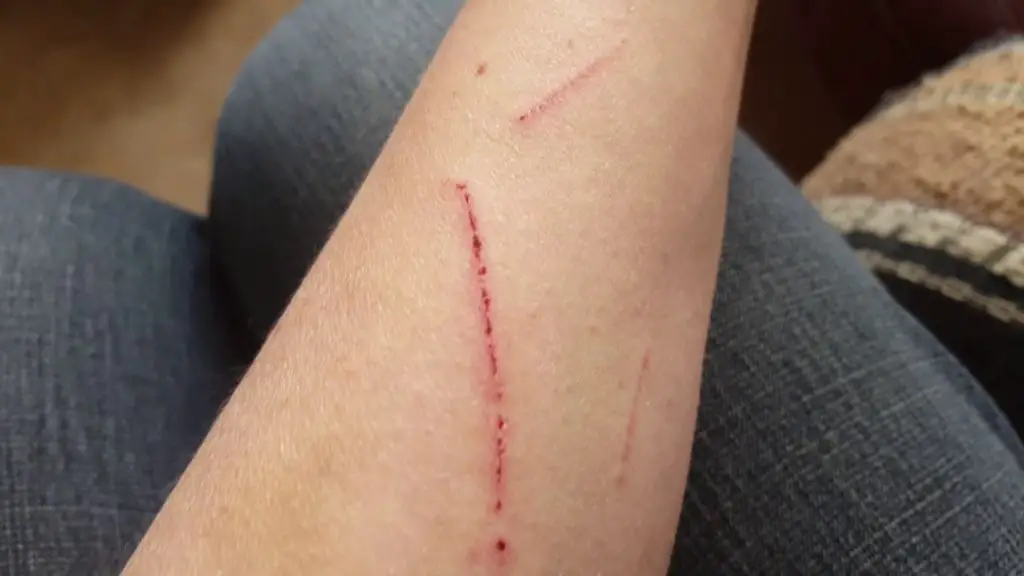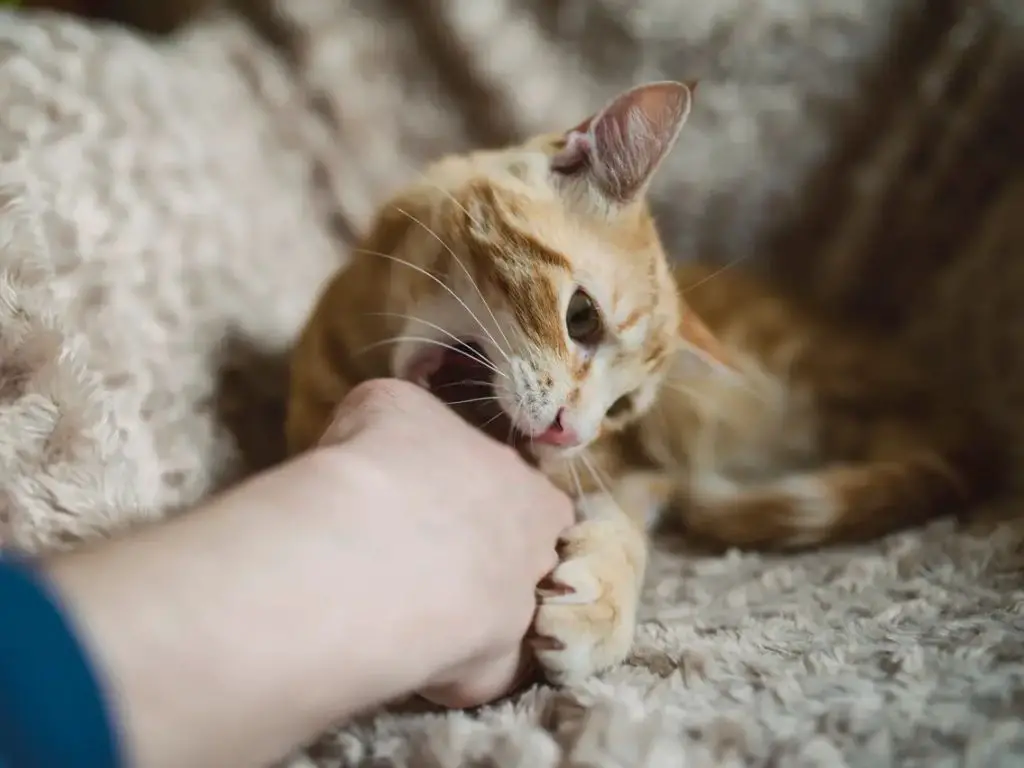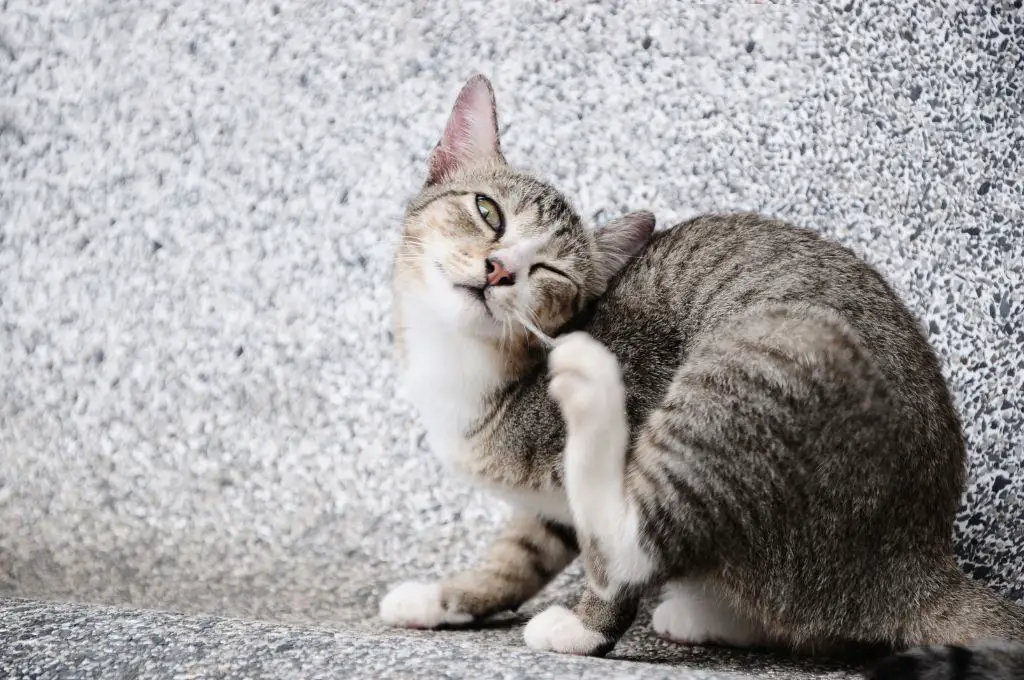What Causes Cat Scratches
Cats use their claws and teeth to scratch and bite for various reasons. Cat scratches can range from superficial surface scrapes to deep puncture wounds depending on the cause and severity.
Some common causes of cat scratches include:
- Playful swats during playtime or petting. Cats have a strong prey drive and may scratch with claws out during play sessions. These are often light surface scratches.
- Overstimulation. Petting a cat too much can overstimulate them, leading to scratches in an effort to get away.
- Fear or defensiveness. Cats may scratch out of fear if startled or feeling threatened.
- Redirected aggression. A cat that is aroused by another animal or stimulus may redirect that energy and scratch its owner.
- Deliberate aggression. Some cats can scratch and bite quite hard from anger or as a warning. These lead to deeper puncture wounds.
The depth and severity of a cat scratch depends on factors like the cat’s age and strength, whether claws were extended, the body part scratched, and if the skin was pinched and raked versus a glancing swipe.

Kittens and older cats often have weaker scratches. Aggressive, intent scratches from healthy adult cats with all claws extended lead to the deepest punctures and cuts. Areas with delicate skin like the face and neck also sustain worse wounds.
Signs of Infection
Cat scratches can become infected, leading to redness, swelling, warmth, and pus at the wound site. According to the CDC, the infected area may appear swollen and red with round, raised lesions and can have pus [1]. Other signs of infection include:
- Fever
- Headache
- Poor appetite
If the scratch forms a blister or pustule, it could indicate a bacterial infection. Pus is a sure sign the wound is infected. Redness and warmth around the scratch signifies inflammation. Swelling results from fluid buildup and inflammation. If the scratch shows these symptoms, seek medical care to treat the infection [2].
Treating Minor Scratches
For minor cat scratches that do not break the skin, basic first aid can promote healing and reduce the risk of infection. It is important to properly clean the wound by rinsing it with clean, running water for at least 5 minutes to flush away dirt, debris, and bacteria according to PetMD. Do not scrub the wound, as this can cause further irritation. After rinsing, a mild soap can be used to gently cleanse the area. Make sure to rinse away all soap residue.

Applying an antibiotic ointment, like Neosporin, can help prevent infection by inhibiting bacterial growth. The ointment should be applied in a thin layer and covered with a sterile bandage according to Preventive Vet. Bandaging protects the wound site, absorbs drainage, and keeps the antibiotic ointment localized. Bandages should be changed daily to monitor healing and check for signs of infection. Over-the-counter pain medication can also be used to alleviate discomfort.
Proper first aid treatment for minor scratches helps facilitate the healing process and reduce the chances of complications. Monitoring the wound site and watching for symptoms of infection is important. If the scratch worsens or shows signs of infection, seeking medical attention is recommended.
Seeking Medical Care
Most minor cat scratches heal within 5-10 days without medical intervention. However, it’s important to monitor the wound and watch for signs of infection, which can occur if bacteria enter the scratch. According to Healthline, you should call your doctor if the scratched area becomes increasingly red, swollen, warm/hot to the touch, or tender over the first 48 hours after the scratch occured. Other signs of infection include oozing pus, enlarged lymph nodes near the scratch, red streaks leading from the wound, or flu-like symptoms within 3-10 days of being scratched (source).
Cat scratches that break the skin should be seen by a doctor if they do not show signs of healing within 10-14 days. Deep scratches or bites always warrant medical attention to properly clean the wound, assess for damage, and prescribe antibiotics if needed. Children, pregnant women, elderly, and immunocompromised individuals should also seek care for any cat scratches that break the skin, as they are at higher risk of infection.
Preventing Infection
To prevent infection from cat scratches, it’s important to properly clean the wound. The CDC recommends washing cat scratches with soap and running water. Be sure to wash away any dirt or debris and clean the wound thoroughly. You may need to scrub gently around the wound to remove any bacteria.
Keep the wound covered with a clean bandage until it has fully closed. Change the bandage at least once a day or whenever it becomes dirty or wet. Check for signs of infection each time you change the bandage, including redness, swelling, warmth, increased pain, and pus.
If the scratch is deep, you may want to apply antibiotic ointment before bandaging. However, stop using the ointment once a scab has formed as keeping the wound moist could delay healing. Avoid using hydrogen peroxide or iodine, which can damage tissue.
Be diligent about checking for infection and contact your doctor right away if you notice any concerning symptoms. With prompt care, most minor cat scratches can heal without complications.
Watching for Complications
While most cat scratches heal without issue, there are some potential complications to watch out for. Two concerning bacterial infections that can result from cat scratches are cat scratch disease and tetanus.
Cat scratch disease is caused by the bacteria Bartonella henselae, which can be present in a cat’s saliva. According to the CDC, symptoms usually appear 3-14 days after a scratch or bite and include swollen lymph nodes, fever, headache, fatigue, and poor appetite (CDC). In rare cases, the infection can spread to other areas of the body such as the eyes, liver, or spleen.

Tetanus is caused by the bacteria Clostridium tetani, which also may be present on a cat’s nails or teeth. Per Johns Hopkins Medicine, tetanus can cause painful muscle contractions, particularly of the jaw and neck muscles (Johns Hopkins). Tetanus is prevented through proper vaccination, but if you experience muscle spasms after a cat scratch you should seek medical attention.
While less common, cat scratches can potentially transmit rabies as well if the cat is infected. According to the CDC, symptoms of rabies include fever, headache, weakness, and discomfort at the site of the bite (CDC). Rabies is almost always fatal once symptoms appear, so post-exposure treatment is critical.
Monitor any cat scratches carefully and contact your doctor if you notice signs of infection. Prompt treatment can help prevent serious complications from developing.
Caring For Your Cat
Trimming your cat’s claws regularly will help minimize destructive scratching behaviors. Use cat-safe nail clippers to trim the sharp tip off each claw every 2-3 weeks. Only trim the translucent portion at the end, avoiding the pink quick inside.
Make sure your cat has plenty of playtime and interactive toys to keep them mentally and physically stimulated. Boredom and pent up energy can lead to destructive scratching. Try interactive toys like feather wands, puzzle feeders, laser pointers, and more. Play with your cat for at least 15-30 minutes per day.
If your cat’s scratching seems tied to stress or anxiety, there are things you can do to help them feel more secure. Provide plentiful scratching posts and boards around your home so they have acceptable outlets. Use calming pheromone diffusers and calming treats or supplements. Start positive reinforcement training to boost confidence. In extreme cases, speak to your vet about anti-anxiety medication.
Signs of Healing
As cat scratches start to heal, you will notice some common signs of the healing process. These include:
Scabbing: Within the first few days, a protective scab will usually form over the scratch. This helps prevent infections and promotes healing. The scab protects the new skin cells forming underneath. Scabs normally last around 1 week before naturally flaking off as the scratch heals.
Itching: As the scratch heals, it is common to feel mild itching or tingling around the area. This is a sign of the wound healing and new skin cells replacing damaged ones. Try not to scratch or pick at scabs as this can reopen the wound.

Fading marks: Over several weeks, any redness, swelling, or discoloration from the scratch should steadily fade. The new skin cells filling in the scratch will blend with surrounding normal skin. Deeper scratches may leave a faint mark or line after healing completely.
According to Quora, minor cat scratches usually heal within 1-2 weeks, while deeper scratches may take 3-4 weeks to fully heal. Noticeable improvements should be seen each week.
Scarring
Whether a cat scratch leaves a permanent scar depends on several factors:
- Depth of the scratch – Deeper scratches that damage multiple layers of skin are more likely to scar.
- Location on the body – Areas with thicker skin like the palms and soles are less prone to scarring than thinner-skinned areas like the face.
- Wound care – Properly cleaning and dressing the scratch can minimize scarring. Letting wounds heal openly increases scarring risk.
- Infection – Infected scratches often scar worse than uninfected wounds.
- Genetics – Some people are more prone to hypertrophic or keloid scarring.
While not all scratches scar, taking precautions can reduce the chances:
- Clean the scratch right away with soap and water. Apply antibiotic ointment.
- Cover with a bandage to keep it moist and protected.
- Watch for signs of infection like redness, swelling, heat, and pus.
- See a doctor for deep scratches or those showing infection.
- Once healed, use silicone scar sheets or gel to minimize visible scarring.
With proper care, most mild cat scratches heal without significant scarring. More severe wounds may leave some permanent marks, especially on the face or body.
When to Worry
Most cat scratches heal without issue, but there are some unusual symptoms to look out for that may indicate a more serious problem. According to the CDC, contact your doctor if the scratch site develops red streaking, the wound does not heal within 10 days, or the skin around the scratch becomes hot and extremely tender [1]. These could be signs of a deeper bacterial infection that requires medical treatment.
You should also be concerned if you develop a high fever, chills, muscle aches, swollen lymph nodes, or other flu-like symptoms, as these may indicate cat scratch fever/disease. Cat scratch fever is caused by a bacterial infection transmitted in cat saliva and typically causes swollen lymph nodes near the original scratch, fever, fatigue, headaches, and poor appetite [2].
In summary, contact your doctor promptly if the scratch shows signs of infection like redness, swelling, oozing, and warmth or if you develop fever, lymph node swelling, or other concerning systemic symptoms. Careful wound care and monitoring for unusual changes can help prevent cat scratches from becoming seriously infected.

